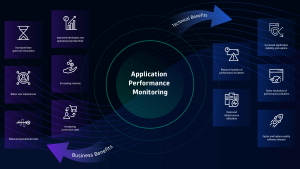Application performance monitoring (APM) for modern, cloud-native environments extends observability beyond system availability and service performance and response times. Automatic and intelligent observability helps organizations improve user experiences at the scale of modern computing.
What is APM?
Application performance monitoring (APM) is the practice of tracking key software application performance metrics using monitoring software and telemetry data. Practitioners use APM to ensure system availability, optimize service performance and response times, and improve user experiences.
Mobile apps, websites, and business applications are typical use cases for monitoring. However, with today’s highly connected digital world, monitoring use cases expand to the services, processes, hosts, logs, networks, and end-users that access these applications — including a company’s customers and employees.
Check out this session from Perform 2023 conference “Improve application performance with AI-powered exploratory analytics”
What does APM stand for?
APM stands for Application Performance Monitoring.
Though that meaning is specific to the topic discussed in this article, APM has additional meanings and can be referred to as all the below:
- Application monitoring
- Application performance monitoring
- Application performance management
- Application performance
- Performance monitoring
The focus of application performance monitoring is on specific metrics and measurements; application performance management is the wider discipline of developing and managing an application performance strategy. All these terms refer to related technology and practices.
Why do we need APM?
Digital teams use APM tools to view and address the many variables that can impact an application’s performance. Without these tools, teams struggle to resolve the numerous problems that can arise — raising the likelihood of customers becoming frustrated by the poor experience and abandoning the app altogether.
Every day, customers use apps to shop, stream TV shows and movies, connect to social media, manage finances, and work. In the age of working from home, customers rely more than ever on these apps to conduct their daily lives. When an app crashes, is slow to load, or doesn’t load at all, users become frustrated, which can cause the business to suffer brand damage or lose revenue. When an internal business application begins to falter, the company may also see reduced employee productivity.
However, digital teams often find it difficult to find the root cause of an application performance problem. Causes can run the gamut — from coding errors to database slowdowns to hosting or network performance issues. Even a conflict with the operating system or the specific device being used to access the app can degrade an application’s performance.
Modern applications such as mobile apps, websites, and business apps may seem simple on the surface, but they are actually highly complex. Millions of lines of code comprise these apps, and they include hundreds of interconnected digital services and open-source solutions, and run in containerized environments hosted across multiple cloud services.
What does APM do?
APM has rapidly expanded to encompass a broad range of technologies and use cases. According to Gartner, “Application performance monitoring is a suite of monitoring software comprising digital experience monitoring (DEM), application discovery, tracing and diagnostics, and purpose-built artificial intelligence for IT operations.”
APM core features
The Gartner® Magic Quadrant™ for APM and Observability, a leading industry report on APM, provides a clear definition of APM’s core capabilities as they have matured. These capabilities set the bar for modern APM solutions.
- Automatic discovery and mapping of application and its infrastructure components to maintain real-time awareness in dynamic environments
- End-to-end observability of an application’s complete HTTP/S transactional behavior to understand the effect on business outcomes and user experience
- Mobile and desktop application monitoring on mobile and desktop browsers to track user experience across platforms
- Root-cause and impact analysis of application performance problems and business outcomes for faster, more reliable incident resolution
- Integration and automation with service management tools and third-party sources to keep pace with an expanding and evolving infrastructure
- Business KPIs and user journey analysis (for example, login to check out) to optimize user experiences and provide transparency into how changes impact KPIs
- Endpoint monitoring to understand how mobile applications impact endpoint devices and identify issues with those devices
- Virtual desktop infrastructure (VDI) monitoring to maximize the productivity of employees using VDI
These capabilities extend into many areas. Here are a few of the most common ones:
- API monitoring to understand how application performance is impacted by third party services
- Application architecture to gain insights into how application architecture changes impact performance and user experience
- Service monitoring to understand how individual services interact and their impact on overall application performance
- Container monitoring to help understand the context and performance impact of individual containers
- End-user experience monitoring to help you understand how changes to applications affect your end users
What are the benefits of APM?
APM gives businesses increased visibility and intelligence into the performance of applications and their dependencies to detect and pinpoint application performance issues before real users are impacted. APM delivers an impressive and expanding list of technical benefits and business benefits.
Technical benefits
Business, operations, application, and development teams can expect to enjoy several practical benefits from adopting APM practices and tools, such as:
- Increased application stability and uptime
- Reduced number of performance incidents
- Faster resolution of performance problems
- Faster and higher-quality software releases
- Improved infrastructure utilization
Concrete business benefits
Those in the boardroom have just as much to gain from adopting APM solutions as those on the front lines of DevOps efforts. Business benefits include:
- Improved developer and operational productivity
- Increased time spent on innovation
- Better user experiences
- Increasing revenue
- Reduced operational costs
- Increasing conversion rates
Soft business benefits
Long-time APM users also report that APM has given their organizations some unexpected but impactful advantages.
Most prominent among these positives is the ability to collaborate more easily. The new insights and reliable intelligence afforded by a good APM solution enable teams across the organization to be more confident. In turn, this single source of reliable intelligence all parties can agree on helps application, operations, and development teams to align faster and easier when problems arise and to work together more effectively. More effective collaboration helps teams resolve problems faster, which can make frustrating war rooms a thing of the past. As a result, leaders see increased job satisfaction among their team members, leading to higher staff retention.

Why cloud-native applications make APM challenging
Even though the benefits of APM are well established, the rise of cloud-native applications has made it more challenging to do well. For example, cloud-native apps generate far greater quantities of telemetry data because they are made up of a myriad microservices that dynamically spin up and spin down in the background. Each of these microservices exists for a short period and generates its own telemetry data, adding to the overall signal noise. When this happens, it becomes more difficult to find the most important events taking place within your application infrastructure.
Cloud-native apps also produce many kinds of data. Telemetry data from a serverless environment is quite different from a database or a virtual machine (VM), for example, but a business still needs to normalize and centrally manage all the information as it comes in. The velocity at which this data is created is another problem. When a cloud-native app includes many smaller microservices, data comes in at a much faster rate than with a monolithic application. All these factors have added new challenges that make traditional APM more difficult in a cloud-native application environment.
APM tools vs. APM platforms
What are APM tools?
APM tools are often designed to look at one specific aspect of application performance. These point solutions can help identify specialized issues. Over time, organizations often find themselves using multiple APM tools that don’t necessarily integrate with one another or provide comprehensive insight into the application environment.
What are APM platforms?
An APM platform provide a single integrated platform using AI and automation to deliver a precise, context-aware analysis of the application environment. Organizations can continuously monitor the full stack for system degradation and performance anomalies by utilizing an APM platform.
With the deluge of telemetry data that comes with cloud-native apps comes a profusion of performance monitoring tools and platforms.
Organizations can take one of two approaches when picking APM tools. By default, or by design, different teams may deploy a combination of point solutions. Or, they may choose a single platform that more fully encompasses the many layers and use cases within the application environment. Point solutions can pose benefits at a local level and challenges at a macro level, while a platform approach embraces a modern vision of APM that demonstrates clear advantages at the local and macro levels.
Benefits of point solutions
Point solutions are specialized to monitor specific components and provide advantages for those specific use cases. For example, some companies use Grafana to consolidate their metrics visualizations in a single dashboard while others use Jaeger for its distributed tracing capabilities to gain better observability into their systems and troubleshoot performance issues. Both these tools are highly specialized for the environments they’re applied to.
Teams focused on solving a specific, specialized issue, such as implementing a service mesh to help manage orchestration in their Kubernetes environment, turn to point solutions because they’re cost-effective and easy to implement.
Challenges of point solutions
Point solutions only provide a limited view of a company’s application architecture. This limited visibility makes it harder to identify root causes of application performance issues, resulting in longer downtimes when problems arise. Further, they only provide a single view of the application architecture, often missing the “cause and effect” of performance problems — for example, increased CPU usage caused by a microservice failure. This may result in unnecessary troubleshooting exercises and finger-pointing, not to mention wasted time and money.
Because the scope of these solutions is limited by their nature, they also tend to create silos in which teams can disagree on service-level objectives (SLOs) and metrics. This silo effect can lead to more inefficiency and blame as teams rely on separate tools and different information.
Advantages of a platform approach to APM
Because APM has its roots in the era of monolithic applications before the rise of microservices, open-source technologies, and cloud-native environments, some industry observers have argued that APM platforms lack the innovation and deep-dive capabilities required to keep up with bespoke point solutions. This may be true for many traditional APM platforms.
However, a platform that is purpose-built for cloud-native environments and uses a simple, automated deployment model, like Dynatrace, can offer broad technological coverage across the full stack, including those bespoke point solutions. By leveraging “agentless” data capture (for application use cases that cannot support an agent-based deployment model) and APIs to ingest data, a cloud-native platform like Dynatrace can broaden its coverage to the entire hybrid-multicloud network. This broad-spectrum observability provides a macro-level view across multiple environments to provide continuous discovery, and the applications that run on them, and proactive anomaly detection prioritized by business impact.
Crucial capabilities of a modern APM platform include AI and continuous automation. With the explosion of observability data, a platform needs to automatically process billions of dependencies in real-time, continuously monitor the full stack for system degradation and performance anomalies and deliver precise answers with root-cause determination.
APM’s many forms
APM monitoring comes in many flavors, including infrastructure monitoring, network monitoring, database monitoring, log monitoring, container monitoring, cloud monitoring, synthetic monitoring, and end-user monitoring, among others. Companies often run dozens of individual monitoring tools at once, especially when they’re holding onto legacy applications and managing them using the tools they find most familiar. Although this may seem like the easiest approach, it frequently creates problems. A single APM solution that delivers full-stack observability can make monitoring all these use cases easy and more reliable.
Full-stack monitoring
As application infrastructures expand to encompass both on-premises and multicloud environments, organizations increasingly understand that only a full-stack monitoring approach can deliver comprehensive visibility into the root causes of issues, wherever they originate. Full-stack monitoring allows you to monitor your entire infrastructure from end to end — encompassing everything from infrastructure health to application performance and even the end-user experience. With this visibility, you can see all these components and understand the interdependencies between them, getting faster answers to all your questions.
Advantages of an advanced APM platform
The Dynatrace software intelligence platform provides all-in-one advanced observability for APM use cases that serve business, operations, application. AI assistance enables teams to automate operations, release software faster, and deliver better business outcomes. With the Davis® AI engine at its core, Dynatrace provides precise answers to complex questions in real time.
Advanced cloud observability
With the scale, diverse functionality, and dynamic nature of cloud platforms such as AWS, Azure, and GCP, APM solutions need to just work without configuration or model training. Dynatrace provides complete observability out-of-the-box for dynamic cloud environments, at scale and in context. It includes performance metrics, logs, traces, entity relationships, and user experience and behavior data, and data from the latest open-source standards, including OpenTelemetry, all in a single platform, automatically, with no configuration required.
Continuous automation
Trying to manually maintain, configure, script, and source data in a cloud-native environment is beyond human capabilities, which means organizations must continuously automate these tasks to ensure proper application performance. Dynatrace enables automation through automatic deployment, configuration, discovery, topology, performance, and updates. Davis® doesn’t need to learn because it already knows, and is continuously and automatically observing, analyzing, providing answers, and prioritizing what matters.
AI assistance
AI assistance empowers teams by reducing manual or redundant work, allowing them to be more productive in areas of critical importance to the business. Here, too, Davis® provides precise answers for proactive problem resolution and performance improvements in real time. Customers report that Davis® automatically multiplies the power and effectiveness of the entire team, supercharging the organization’s ability to quickly resolve application performance issues.
Cross-team collaboration
Dynatrace was built for enterprise-scale deployments. With its ease of use and an unlimited users, companies can eliminate silos and accelerate teamwork. Because Dynatrace combines a unified data platform with advanced analytics to provide a single source of truth for biz, ops, app and dev teams, they can go faster and deliver consistently better results with less friction.
User experience and business analytics
Experience and outcomes matter, whether the application is mobile app-to-user, IoT device-to-customers, or a web application behind the scenes. That’s why the Dynatrace platform encompasses the edge device and API. With intelligence into user sessions, including Real User Monitoring and Session Replay, teams can connect user experiences to business outcomes such as conversions, revenue, and KPIs. With data-backed decisions, answers at the ready, and real-time visibility into business KPIs, companies consistently and more efficiently deliver better digital business outcomes across all their channels.
Leading vendors in the APM market
Gartner names leading vendors in the APM market in its annual Magic Quadrant report, giving APM users valuable insight into which solutions are best suited to their unique needs. Gartner positions each vendor into various quadrants on a graph, rating them according to their leadership position within the market and their completeness of vision.
Dynatrace was named a Leader in Gartner’s 2023 Magic Quadrant for APM for the 13th consecutive time, positioned furthest for Completeness of Vision. Dynatrace also recently scored highest in 6 of 6 Critical Capabilities use cases in the 2023 Gartner Critical Capabilities for APM and Observability Report.
Deliver an exceptional user experience with APM
Customers increasingly demand a user experience that is as satisfying as reliable. Effective application performance monitoring gives organizations greater insight into underlying issues.
An APM solution that provides advanced observability through full-stack monitoring and enhanced root-cause analysis gives organizations even greater insight into application performance issues. It also solution provides digital teams with the full suite of capabilities needed to resolve priority issues faster and meet the growing customer demand for a stellar user experience.
To learn more about how Dynatrace delivers exceptional user experiences through APM, explore our interactive APM product tour.





Looking for answers?
Start a new discussion or ask for help in our Q&A forum.
Go to forum